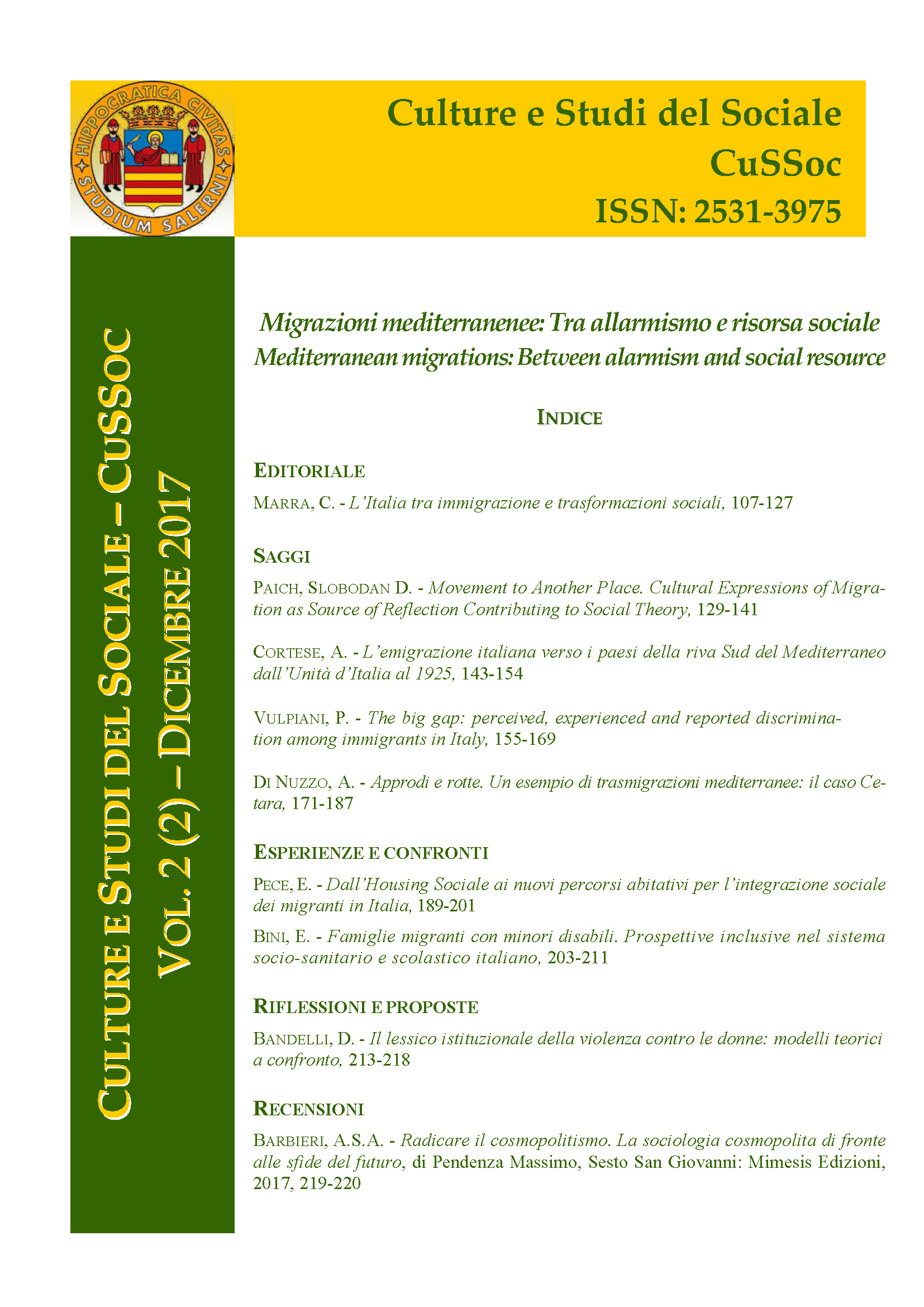The big gap: perceived, experienced and reported discrimination among immigrants in Italy
Abstract
Discrimination experienced by immigrants can only partially be captured by complaints re-ported by anti-discrimination institutions, because of the uncertain will of discriminated migrants of denouncing the racial harassment as well as social, cultural and political con-straints. Comparing the number of reports followed by judicial authorities and equality bod-ies with the results of national statistical surveys is possible to fill the gap between experi-enced and reported discrimination. The article will present a comparison between the num-ber and trends of complaints received by the Italian Equality body against discrimination during ten years, and data from a national inquiry of the Italian Institute of Statistics de-tecting the experiences of discrimination suffered by foreign nationals resident in Italy. The numerical chasm between the two reporting procedures shows the great variability of per-ceived, experimented and complained discrimination, offering at the same time an in-depth and original overview of xenophobia and discrimination in Italy.
References
AMBROSINI M. (2013), ‘We are against a multi-ethnic society’: policies of exclusion at the urban level in Italy, Ethnic and Racial Studies, 36, N.1, 136-155.
BILLIET J., MEULEMAN B., DE WITTE H. (2014), The relationship between ethnic threat and economic insecurity in times of economic crisis: Analysis of European Social Survey data, Migration Studies, Vol. 2, N. 2, 135-161.
BORDIEU P. (1980), Le racisme de l’intelligence, Questions de Sociologie, Ed. de Minuit, p. 264-268.
CASTEL R. (2007), La discrimination négative. Citoyens ou indigène? Seuil, La République des Idées.
COUNCIL OF EUROPE (2012), Human Rights of Roma and Travellers in Europe, COE, Strasbourg.
CROCKER J.,& MAJOR B. (1989), Social stigma and self-esteem: The self-protective properties of stigma, Psychological Review, 96, 608-630.
CROCKER J.,& MAJOR B. (1994), Reaction to stigma: The moderating role of justification, In M.P. Zanna & J.M. Olsen (Eds.),The psychology of prejudice: The Ontario symposium, Hillsdale, NJ: Lawrence Erlbaum, pp.289-314.
CROSBY F. (1982), Relative deprivation and working women. New York: Oxford Univer-sity Press.
DANISH INSTITUTE FOR HUMAN RIGHTS (Ed.) (2007), Tackling Multiple Discrimination. Practices, policies and laws, Publication of the EC Directorate-General for Em-ployment, Social Affairs and Equal Opportunities, Unit G4.
DION K.L., KAWAKAMI K. (1996), Ethnicity and Perceived Discrimination in Toronto: Another Look at the Personal/Group Discrimination Discrepancy, Canadian Journal of Behavioural Science, 28: 3, pp.203-21.
EUROPEAN COMMISSION (2015), Eurobarometer on Discrimination 2015, General perceptions, opinions on policy measures and awareness of rights, DG Justice and Con-sumers.
FASSIN D. et E. (sur la direction de) (2006), De la question sociale à la question raciale? Representer la société française, Paris, La Découverte / Poche.
FRA (2012), The situation of Roma in 11 EU Member States, European Union Agency for Fundamental Rights, Luxembourg.
FRA (2012), EU-Midis Data in focus : Minorities as victims of crime, European Union Agency for Fundamental Rights. http://fra.europa.eu/en/publication/2012/eu-midis-data-focus-report-6-minorities-victims-crime
FULLIN G. (2011), Unemployment trap or high job turnover? Ethnic penalties and labour market transitions in Italy, International Journal of Comparative Sociology, Vol. 52 N. 4, 284-305.
KAHN K. B., SPENCER K., GLASER J. (2013), Online prejudice and discrimination: From dating to hating, in Y. Amichai-Hamburger (Ed.), The social net: Understanding our online behavior, Oxford, Oxford University Press, pp. 201-219.
MAJOR B., GRAMZOW R. H., MCCOY S. K., LEVIN S., SCHMADER, T., & SIDANIUS, J. (2002), Perceiving personal discrimination: The role of group status and legitimizing ideology, Journal of Personality & Social Psychology, 82, 269-282.
MAKKONEN T. (2002), Multiple, Compound and Intersectional Discrimination: Bringing the Experiences of the Most Marginalized to the Fore, Institute for Human Rights.
MOON G. (2006), Multiple discrimination – problems compounded or solutions found?, Justice Journal, 86-102.
OSCE ODHIR (2008), Status Report 2008, OSCE, Warsaw.
PADILLA A., PEREZ W. (2003), Acculturation, Social Identity, and Social Cognition: A New Perspective, Hispanic Journal of Behavioral Sciences, Vol. 25 No. 1, pp. 35-55.
PIASERE L. (2012), Scenari dell’antiziganismo. Tra Europa e Italia, tra antropologia e politica, SEID, Firenze.
RUGGIERO K.M.,& TAYLOR,D.M.(1997),Why minority group members perceive or do not perceive the discrimination that confronts them: The role of self-esteem and per-ceived control, Journal of Personality & Social Psychology, 72, pp. 373-389.
SÁEZ J., GIMÉNEZ S. (2014), Practical Guide for Police services to prevent discrimination against the Roma communities, Net-Kard Project.
TURNER C.B.,TURNER B. F. (1981) , Racial Discrimination in Occupations Perceived and Actual, Phylon (1960-), Vol. 42, No. 4 (4th Qtr., 1981), pp. 322-334.
VULPIANI P. (2014), I volti dell'intolleranza. Xenofobia, discriminazioni, diritti e pratiche di convivenza, Armando editore.
WIEVIORKA M. (1996), Lo spazio del razzismo (1991), Il Saggiatore EST.
ZOLBERG A. (1987), Wanted but not welcomed: alien labor in Western development. In Alonso W. (Ed.), Population in an Interacting World, Cambridge, Harvard University Press, 36-73.


